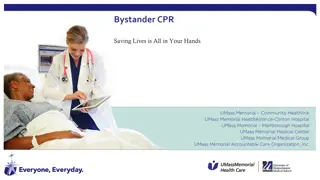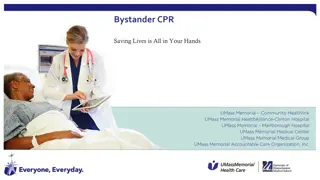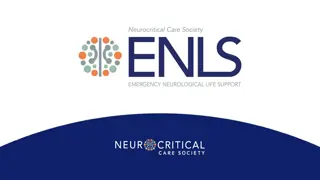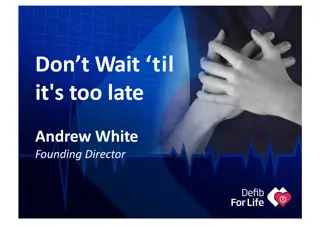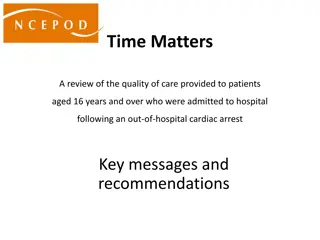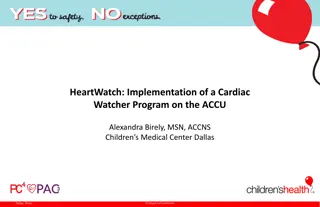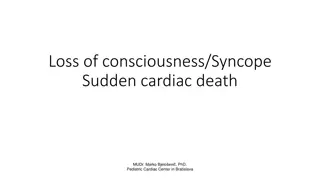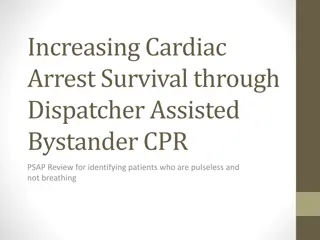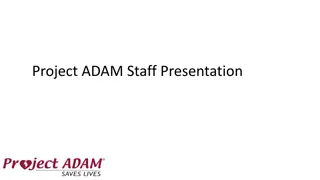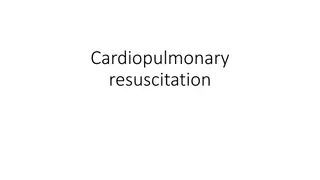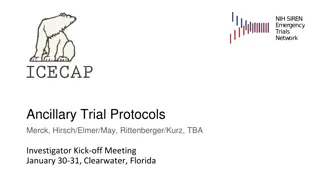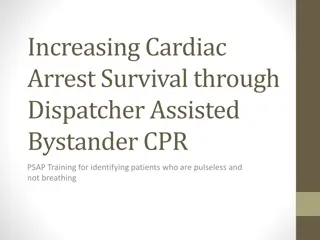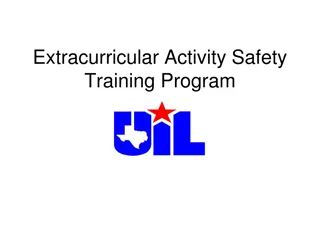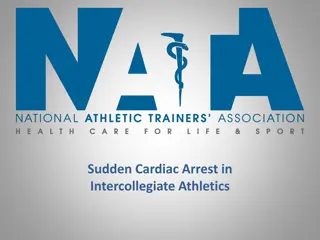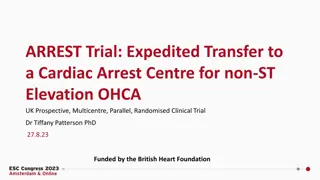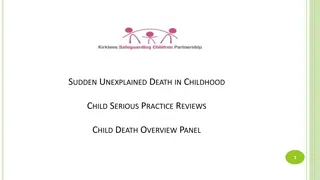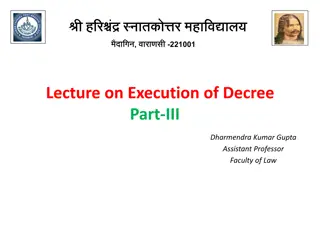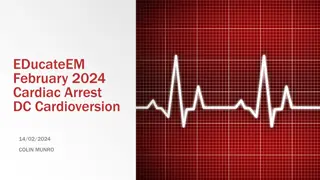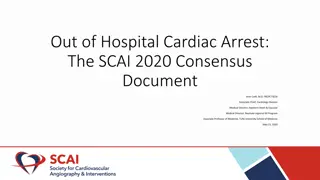Understanding Sudden Cardiac Arrest: Facts, Statistics, and Treatment
Sudden cardiac arrest is a critical condition where the heart suddenly stops beating, leading to a lack of blood flow to vital organs. Learn about the definition, statistics, importance of early CPR, and treatments for sudden cardiac arrest to increase survival rates. Bystander participation in performing CPR and using AEDs before EMS arrival significantly improves outcomes.
Download Presentation

Please find below an Image/Link to download the presentation.
The content on the website is provided AS IS for your information and personal use only. It may not be sold, licensed, or shared on other websites without obtaining consent from the author. Download presentation by click this link. If you encounter any issues during the download, it is possible that the publisher has removed the file from their server.
E N D
Presentation Transcript
Public CPR Education By: Brandon Looper
What is Sudden Cardiac Arrest? According to nih.gov, sudden cardiac arrest is defined as is a condition in which the heart suddenly and unexpectedly stops beating. When this happens, blood is not flowing to the organs, specifically the heart and brain itself. A patient in sudden cardiac arrest is considered clinically dead at that moment. (below is asystole, otherwise known as flat line . This patient is clinically dead)
Sudden Cardiac Arrest Statistics According to sca-aware.org, approximately 326,200 people die yearly from sudden cardiac arrest. Sudden cardiac arrest is the leading cause of death each year, second being Alzheimer s disease. Approximately 9 of 10 people suffering from sudden cardiac arrest ultimately die. This is due to lack of bystander participation prior to EMS arrival.
Treatment for Sudden Cardiac Arrest AHA provides several guidelines to the treatments of cardiac arrest. The advanced treatments include: oral intubation, intravenous therapy, cardiac drug administration, and much more. The only 2 proven treatments in cardiac arrest are adequate, high quality CPR and early defibrillation. These are 2 very simple treatments that are proven to work and can be done prior to EMS arrival.
The Importance of Early CPR As previously stated, in sudden cardiac arrest blood is not flowing to any of the organs. According to braininjuryfoundation.org, without oxygen reaching the brain, irreversible brain damage starts to occur within 5 minutes. Average response times for local fire departments nationwide is around 4 minutes. While this seems relative quick, this is once the fire department or EMS service receives the call. First, a person must recognize the sudden cardiac arrest, call 911, dispatcher must gather adequate information, then dispatch the nearest unit. After this process, it could easily be 5 minutes or greater. The brain begins to die at 5 minutes.
Sudden Cardiac Arrest Statistics with Pre-Arrival Assistance As previously stated, patients suffering from sudden cardiac arrest with no assistance prior to EMS arrival have a very poor chance of survival. Specifically, 9 out of 10 patients die without assistance prior to EMS arrival. According to sca-aware.org, with bystanders performing CPR and use of an AED prior to EMS arrival, 4 out of 10 patients survive. This is a 300% increase in survival.
How Can We Gain Participation in Bystander CPR? The first step to gaining participation in bystander CPR is making it simple. According to the American Heart Association (AHA), the number 1 reason bystanders do not perform CPR is they are scared they will either do it wrong, or harm the patient. AHA now recommends teaching hands-only CPR to the public. This takes out breathing aspect of CPR. This makes bystander CPR easier for the bystander. The second aspect of gaining bystander participation of CPR is adequate training. If the public is trained in hands- only CPR, they will feel more comfortable performing CPR if needed. Also, hands-only CPR is quick, simple, and not as intense as full BLS CPR certification. The third key to participation is pre-arrival instructions by the dispatcher. Today, we have Emergency Medical Dispatchers (EMD). These dispatchers have taken special medical training and are certified in CPR. During a sudden cardiac arrest event, the dispatcher is supposed to give step-by-step instructions to the bystanders to initiate CPR. This significantly increases the patients change of survival.
How to Train the Public in Hands-Only CPR Now, arguably the hardest part, training the public. There are two ways this needs to be done. First, we need to set a plan in place where over time, the growing young will obtain CPR. The way to do this is by teaching a required CPR course in high school. Many states in the US have passed laws making it law for a high school student to have a minimum of hands-only CPR training before they are eligible to graduate. This will ensure that the you from the first class on, will always have CPR training they can carry with them throughout their lives. Second, is training the people that are out of high school. The way to do this is by offering free hands-only CPR training in public places. Hands-only CPR only takes approx. 20 minutes to teach, making it easy to teach in public. AHA Mini Annie training systems can be purchased on grants and public donations. Places to have a quick hands-only CPR training are: sports gatherings, fairs, festivals, parades, etc.
The Story of a Survivor Cardiac arrest is a serious, but treatable state. We are passionate about the teaching of CPR for 2 reasons. Number one, we understand the importance of pre-arrival CPR. Second, is the story of a former principal at Pickens High School (He has given me permission to tell his story). A few years ago, there was a 5k run at a special event. This principal entered the race. As he ll tell you, he wasn t in the best of shape, but he was considered a healthy individual. He exercised occasionally and his diet was moderately healthy. He was running in the race and he started towards the back. About half way, he passed one of the counselors that was there for the sole purpose to say, You re half way there! Keep going, you can do this! (with some variation, but unimportant). As the principal ran past him he waved. He made it less than 100ft from the counselor and suddenly collapsed. He d had no chest discomfort, no dizziness, or no abnormal complaints at all. Mr. Lawson went into sudden cardiac arrest. That 1 counselor that he d just passed, was CPR certified. Of the 82 counselors, this 1 was the ONLY CPR certified individual. He quickly ran to the principal, recognized he was in cardiac arrest, directed someone to call 911, and initiated chest compressions. The organization had an ambulance on standby at the event due to the large amount of people involved. They quickly responded and took over. The patient gained a pulse back quickly after. He was transported to a nearby hospital where they found out he was having a heart attack. He underwent open heart surgery, receiving multiple bypasses. He then went on to make a full recovery. He now eats better, exercises more, preaches of his miracle, and spreads the word about the importance of hands-only CPR. Undoubtedly, if it weren t for that 1 counselor that knew CPR, the principal would have died. That 1 counselor did chest compressions until EMS arrived and ultimately saved his life. He has zero deficits from his sudden cardiac arrest incident. He now is able to be at home with his family, be at his son s recent wedding, and much more. He is a true testament that CPR saves lives.
ITS THAT SIMPLE Click the Video
Conclusion In conclusion, sudden cardiac arrest is the most common cause of death in America to date. While this condition has a 90% mortality rate, patient survival odds can easily be increased. This is achieved by initiation of CPR and use of an AED by a bystander prior to EMS arrival. Ways to improvement in participation of bystanders is to make CPR easier by teaching hands-only CPR, having adequate training programs and future training plans, and by implementation of EMDs and pre-arrival instructions by the dispatcher. If done appropriately, these things can dramatically increase a patients chances of survival.
References About SCA. (n.d.). Retrieved March 21, 2016, from http://www.sca-aware.org/about-sca Brain Injury Foundation. (n.d.). Retrieved March 21, 2016, from http://braininjuryfoundation.org/ What Is Sudden Cardiac Arrest? (2015, October 29). Retrieved March 21, 2016, from http://www.nhlbi.nih.gov/health/health-topics/topics/scda



